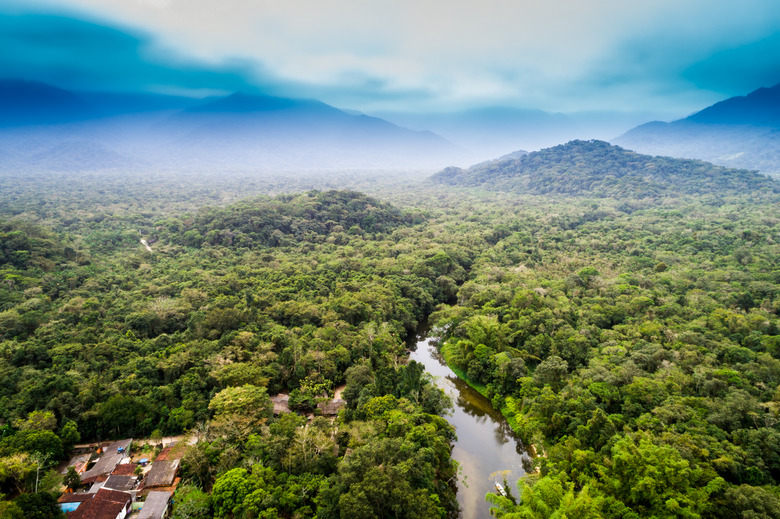The Characteristics Of The Rainforest
We may receive a commission on purchases made from links.
The Amazon Rainforest creates 20 percent of the Earth's oxygen because of its abundant tree and plant life. While the world's tropical rainforests vary — from Africa, Southeast Asia, and South and Central America — they all share key attributes: high precipitation levels and temperatures, poor soil quality and a startling array of biodiversity. Human intervention like forestry, agriculture and mineral extraction continues to harm these valuable ecosystems to this day.
TL;DR (Too Long; Didn't Read)
The Earth is home to three main rainforests found in Africa, Central and South America, and Southeast Asia. These rainforests share similar characteristics: lots of rain, high humidity and temperatures, poor soil quality and abundant biodiversity.
Not Surprisingly, Rainforests Are Wet
Not Surprisingly, Rainforests Are Wet
While the exact amount of rainfall rainforests see varies from year to year and location to location, they all receive copious amounts of rain. South America's rainforests can see from 6 1/2 to 10 feet of rainfall in a single year. That said, deforestation for use as farmland can decrease annual precipitation amounts. In the African rainforests, cutting down rainforest trees can reduce rainfall their peers see by 50 percent. Tropical rainforests are also incredibly humid: 88 percent humid in wet seasons, and 77 percent in dry seasons.
Rainforests Are Warm
Rainforests Are Warm
Earth's three tropical rainforest systems sit between two latitudes called the Tropic of Cancer located at 23°27'N and the Tropic of Capricorn a 23°27'S, hence the term tropic. As these regions either sit near to or, in some cases directly on the equator — the central latitude of the Earth that sees the most sunshine year-round — they tend to be quite warm. The average temperature of a tropical rainforest is 85 degrees Fahrenheit. While, on occasion, temperatures can get much higher, temperatures change very little, 9 degrees, between seasons due to the equator's constant proximity to the sun. High humidity levels makes tropical rainforests feel even hotter.
Surprisingly, Rainforests Have Bad Soil
Surprisingly, Rainforests Have Bad Soil
Rainforests have thick canopies of leaves and provide homes for a staggering variety of species, more than 45,000 in the Amazon alone. Under normal circumstances, this would mean more nutrients in the soil, as members of the ecosystem's biologically-rich makeup die and decompose in the dirt. But the heavy rainfall in these areas washes these nutrients away. Similarly, the hot and moist conditions decompose dead animal and plant matter quickly, causing existing plants to use up the nutrients faster than they would otherwise.
Rainforests Home Half the World's Species
Rainforests Home Half the World's Species
Despite making up only 6 percent of the world's landmass, rainforests contain 50 percent of Earth's land-based species, biologists estimate. To put things in perspective, the rainforests of Borneo house around 2,500 distinct orchid species. The heavy rainfall and easy access to nutrients provide the setting for many thousands of plant species, which, in turn, feed animals, which feed other animals in a never-ending cycle. While each tropical rainforest shares common attributes, many species can be found only in one area, like the sharp-toothed meat-eating piranha fish native to rivers in the Amazon rainforest.
References
Cite This Article
MLA
Johnson, Doug. "The Characteristics Of The Rainforest" sciencing.com, https://www.sciencing.com/characteristics-rainforest-8514049/. 17 April 2018.
APA
Johnson, Doug. (2018, April 17). The Characteristics Of The Rainforest. sciencing.com. Retrieved from https://www.sciencing.com/characteristics-rainforest-8514049/
Chicago
Johnson, Doug. The Characteristics Of The Rainforest last modified March 24, 2022. https://www.sciencing.com/characteristics-rainforest-8514049/
